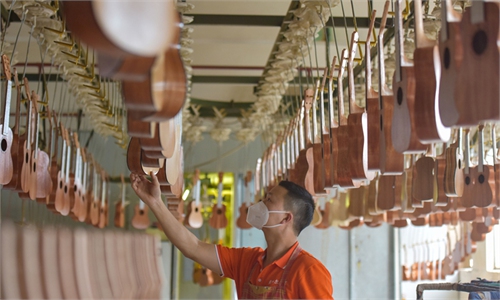ARTS / MUSIC
Wondrous Xinjiang: Keeping Uygur musical heritage alive and well
Art center director Rehman Ablimit enjoys his daily routine of leading actors through rehearsals.
The 53-year-old is from Yarkant county in Northwest China's Xinjiang Uygur Autonomous Region. The county is known as the hometown of the Twelve Muqams, a musical form that consists of sung poetry, stories and music.
This unique art form, known as the "Mother of Uygur Music," comprises a group of classical music pieces combining Uygur song, dance and music, and is considered a treasure of Chinese ethnic music.
It was almost lost once, but thanks to the unremitting efforts of the government, as well as local folk artists, the art form lives on today.
"The government arranges for folk artists to participate in training in the Twelve Muqams for 15 to 30 days every year," according to Rehman Ablimit.
"Each artist receives a subsidy of 50 yuan ($7.50) a day. They learn a Muqam piece every year while rehearsing dances and participating in various programs," he said.
To promote the inheritance of the art form, the local government invested 5 million yuan in the construction of the Muqam art center. The performance hall can accommodate hundreds of performers simultaneously, and any visitor is welcome to learn the art there.
Awut Yuwup, an inheritor of the Twelve Muqams, has taught more than 60 apprentices. He has led his troupe to many provinces in East China to perform and introduce the traditional practice.
"I'm so proud to be a practitioner, as we can perform outside Xinjiang and spread our intangible cultural heritage," he said.
In 2005, the Xinjiang Uygur Muqam Arts of China was approved by UNESCO as a "Masterpiece of the Oral and Intangible Heritage of Humanity."
The 53-year-old is from Yarkant county in Northwest China's Xinjiang Uygur Autonomous Region. The county is known as the hometown of the Twelve Muqams, a musical form that consists of sung poetry, stories and music.
This unique art form, known as the "Mother of Uygur Music," comprises a group of classical music pieces combining Uygur song, dance and music, and is considered a treasure of Chinese ethnic music.
It was almost lost once, but thanks to the unremitting efforts of the government, as well as local folk artists, the art form lives on today.
"The government arranges for folk artists to participate in training in the Twelve Muqams for 15 to 30 days every year," according to Rehman Ablimit.
"Each artist receives a subsidy of 50 yuan ($7.50) a day. They learn a Muqam piece every year while rehearsing dances and participating in various programs," he said.
To promote the inheritance of the art form, the local government invested 5 million yuan in the construction of the Muqam art center. The performance hall can accommodate hundreds of performers simultaneously, and any visitor is welcome to learn the art there.
Awut Yuwup, an inheritor of the Twelve Muqams, has taught more than 60 apprentices. He has led his troupe to many provinces in East China to perform and introduce the traditional practice.
"I'm so proud to be a practitioner, as we can perform outside Xinjiang and spread our intangible cultural heritage," he said.
In 2005, the Xinjiang Uygur Muqam Arts of China was approved by UNESCO as a "Masterpiece of the Oral and Intangible Heritage of Humanity."



